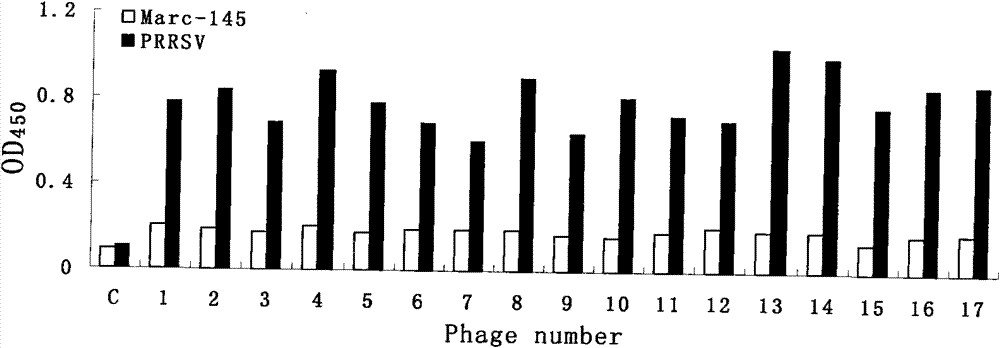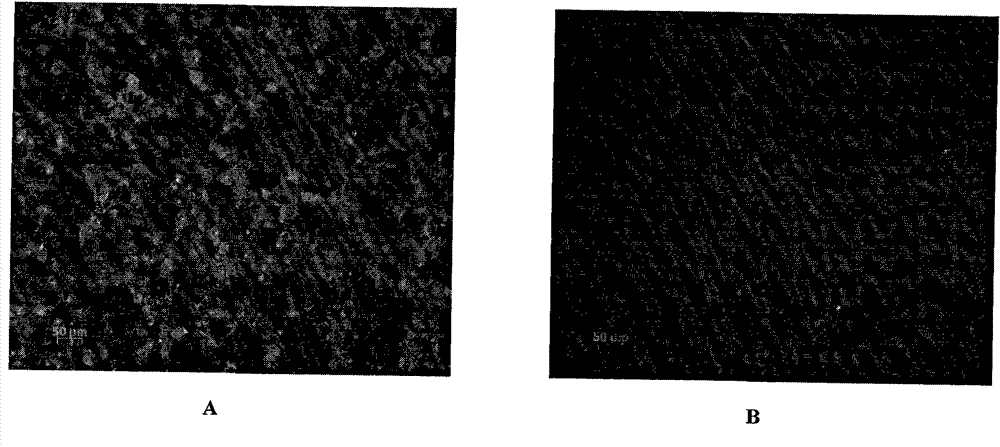Polypeptide capable of specifically bonding porcine reproductive and respiratory syndrome viruses, screening method thereof and use thereof
A technology for respiratory syndrome and pig reproduction, applied in the field of animal virology, can solve the problems of complicated operation steps, low sensitivity and low specificity, and achieve the effects of simple operation, high sensitivity and high specificity
- Summary
- Abstract
- Description
- Claims
- Application Information
AI Technical Summary
Problems solved by technology
Method used
Image
Examples
Embodiment 2
[0040] Example 2 The identification of the bacteriophage screened and the binding characteristics of PRRSV
[0041] 1. Pick a single clone for ELISA identification
[0042] After the third round of screening product (elution product) among the embodiment 1 is diluted, the plates are spread, and each phage monoclonal is picked and inoculated respectively in the early logarithmic growth phase (OD 600 about 0.3) of ER2738 (Ph.D.-12 TM PhageDisplay Peptide Library Kit (purchased from New England Biolabs) was amplified for 4.5 hours, centrifuged to get the supernatant, measured phage titer, and adjusted the concentration to 10 11 pfu / 10 μL.
[0043] Coat the purified PRRSV on the ELISA plate (positive value P), and at the same time coat the lysed supernatant of Marc-145 cells as a negative control (negative value N), coat overnight at 4°C, and block with blocking solution at 4°C for 1 hour the next day The same phage clone was added to the two coated wells, and then the rabbit ...
Embodiment 3
[0061] Example 3 Detection of the inhibitory ability of positive phages to PRRSV
[0062] 1. Amplification of Positive Phage Clones
[0063] Get 5 μ L of the positive phage clone supernatant that embodiment 2 step 1 obtains, add to 20 mL logarithmic growth early stage (OD 600 ~0.3) host strain ER2738 (Ph.D.-12 TM Phage Display Peptide Library Kit (purchased from New England Biolabs), amplified for 4 hours, centrifuged at 10,000 rpm for 10 minutes, supernatant was taken, precipitated twice with PEG-NaCl solution, and finally dissolved with 200 μL of TBS to obtain amplified Positive phage is cloned, and its titer is detected again, and the method is the same as the operation of step 2.2 in the embodiment 1.
[0064] 2. Determination of half tissue infection dose (TCID50)
[0065] Seed Marc-145 cells in 96-well plate in advance, and when the monolayer of cells adheres to 80% of the well, add 10 μL of 1.0×10 11 PFU of phage was mixed with 90 μL of 10-fold serially diluted PRR...
Embodiment 4
[0068] Example 4 FITC-labeled short peptide detection of PRRSV
[0069] 1. Artificial synthesis of FITC-labeled segmented peptides
[0070] Comprehensive comparison of ELISA and TCID 50 As a result of the detection, the phage clone Ph.D-PRRSV-4 was selected, and the short peptide sequence displayed by it was His Trp Trp Ser Trp Pro Ser Tyr Thr Gln Ser Ser, so the short peptide was artificially synthesized: His Trp Trp Ser Trp Pro Ser Tyr Thr Gln Ser Ser-FITC.
[0071] 2. Direct immunofluorescence detection of PRRSV
[0072] Marc-145 cells were grown on 24-well cell culture plates at 5.0 × 10 6 Cells / well were plated, and 200 TCIDs were added to each well after 24 hours to grow into a monolayer of cells 50 The PRRSV virus, and another two wells were kept as controls, and continued to culture for 48h until obvious lesions. After discarding the culture medium, wash with PBS 3 times, fix with ethanol for 10 min, and wash with PBS 3 times. Lyse with 0.3% (v / v) Triton for 5 mi...
PUM
 Login to View More
Login to View More Abstract
Description
Claims
Application Information
 Login to View More
Login to View More - R&D
- Intellectual Property
- Life Sciences
- Materials
- Tech Scout
- Unparalleled Data Quality
- Higher Quality Content
- 60% Fewer Hallucinations
Browse by: Latest US Patents, China's latest patents, Technical Efficacy Thesaurus, Application Domain, Technology Topic, Popular Technical Reports.
© 2025 PatSnap. All rights reserved.Legal|Privacy policy|Modern Slavery Act Transparency Statement|Sitemap|About US| Contact US: help@patsnap.com



